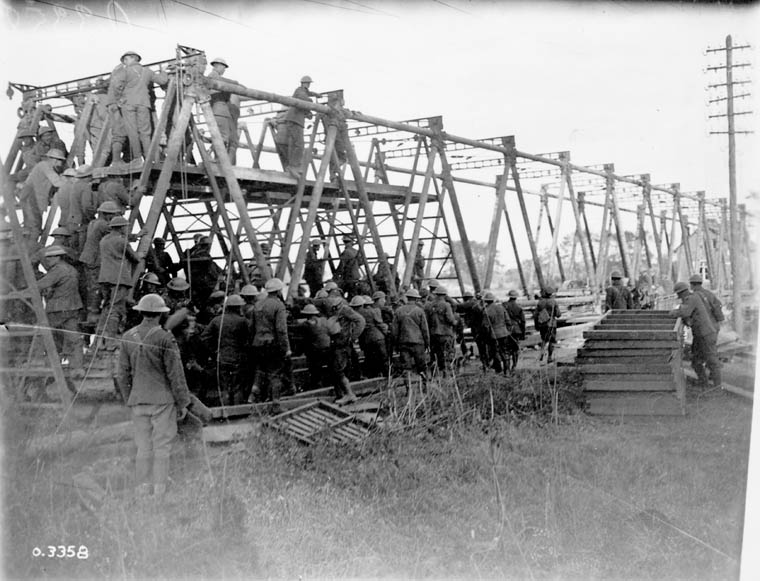by Aadita Chaudhury
Technology & Engineering subject editor

Canadian military engineers constructing a bridge across Canal du Nord; advance East of Arras, Sep 1918. (image courtesy Library & Archives Canada)
Technology and engineering have a pervasive effect on our everyday lives, yet we often struggle to define their scope. My third year engineering class once discussed whether engineering was a science, an art, a combination of both, or something different altogether. Even though we all came from engineering disciplines and had more than three years of engineering education under our belt, nobody could confidently define its theoretical scope. While we all knew what technology and engineering could do, and knew how to recognize something as a product of technology and engineering when we saw it, many of us confessed to having no idea about ‘engineering practice’ when we enrolled in our program.
Even anecdotal evidence from outreach and educational programs suggests that few people – including high school students interested in science – have a clear idea of what professional technologists and engineers do, or of the range of opportunities available to students with an engineering or technology degree or diploma.
March is Canada’s National Engineering Month, with hundreds of events happening across Canada for all school levels and for the public. Not only does it showcase national engineering excellence, but National Engineering Month also introduces young people to the world of engineering through interactions with engineering students, professionals, professors and researchers.
To find out for yourself what engineering’s all about, here are some snippets from Science Borealis – and from around the web:
- From our own feed, Frogheart explores the discovery of what has been termed a 3D version of graphene. Given graphene’s unique physical properties and ability to conduct both heat and electricity, the potential discovery of a 3D version could lead to promising advances in graphene-based applications.
- Cycling infrastructure in cities is a major concern as more residents choose to bike as their primary mode of transportation. Ryan Batty debunks the myth that bike lanes make cyclists less safe at All Roads Lead to Ryan, which covers issues in transportation engineering.
- The Saskatchewan Research Council discusses the role of Research and Technology Organizations (RTOs) in fostering innovation. Because RTOs are distinct from academia, the public sector, not-for profits and for-profit institutions, it puts them in a unique position to explore new technology for the public good without being exclusively motivated by profits.
- Apple products and their operating systems are now household names, and January marked their 30th anniversary. Wired magazine details Apple’s evolution – interesting and visually informative insight into the development and popularization of the personal computer.
- I don’t know about you, but when I hear someone describe a new gadget or technology as “it’s so easy, even your grandma could use it!” I find it silly – to say the least. Comments like these ignore the rich history of women’s involvement in science and technology – some of whom went on to become mothers, grandmothers and great-grandmothers. Check out this nifty blog documenting the lives and successes of grandmas in science, technology, engineering, and mathematics (STEM). It shares stories from a diverse array of women with a range of backgrounds and expertise.
We encourage more submission to the technology and engineering category here at Science Borealis. There are diverse voices out there covering a range of topics from aviation to marine engineering, from transportation to geoengineering. So get writing – and share your bounty with us here at Science Borealis!





One thought on “So what, exactly, does an engineer do?”
Comments are closed.